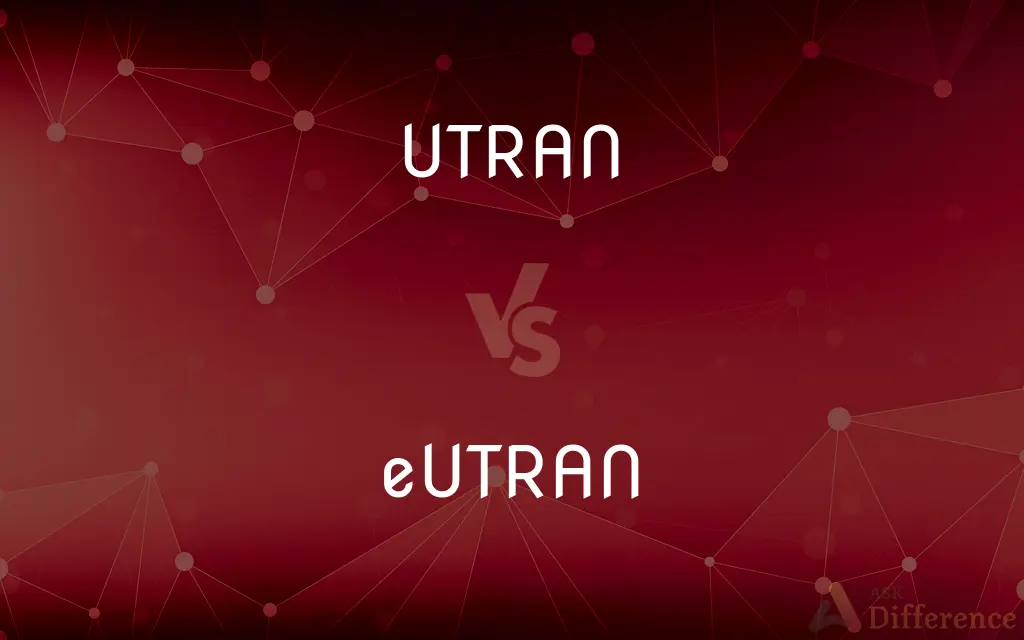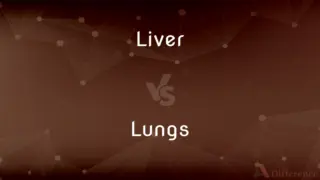UTRAN vs. eUTRAN — What's the Difference?
By Tayyaba Rehman & Urooj Arif — Published on February 7, 2024
UTRAN (Universal Terrestrial Radio Access Network) is the radio access network in 3G UMTS, while eUTRAN (evolved UTRAN) is the radio access component of the 4G LTE system.

Difference Between UTRAN and eUTRAN
Table of Contents
ADVERTISEMENT
Key Differences
UTRAN is the heart of the 3G network, providing the air interface for UMTS mobile telephony standards. It connects mobile devices to the core network through radio frequencies. On the other hand, eUTRAN, also known as the LTE Radio Access Network, represents the evolution in radio access technology, offering enhanced speeds and improved efficiency, marking a significant leap from 3G to 4G technologies.
In terms of architecture, UTRAN consists of Node Bs (base stations) and Radio Network Controllers (RNCs), which manage the resources and handovers within the 3G network. Conversely, eUTRAN simplifies this structure by utilizing a flat architecture where the evolved Node Bs (eNodeBs) handle much of the RNC's functionality, leading to reduced latency and more direct communication pathways in 4G networks.
While UTRAN operates on Wideband Code Division Multiple Access (WCDMA), a 3G technology that provides high data speed and capacity, eUTRAN uses Orthogonal Frequency-Division Multiple Access (OFDMA) for downlink and Single Carrier Frequency Division Multiple Access (SC-FDMA) for uplink. These technologies offer improved spectral efficiency and bandwidth management, integral to the performance enhancements seen in 4G LTE.
From an operational standpoint, UTRAN's primary focus was to deliver a robust, voice-centric service with data capabilities. In contrast, eUTRAN was designed with a data-first approach, reflecting the increasing demand for high-speed mobile data services, thereby providing superior data throughput and reduced latency.
Finally, when considering the evolution of mobile networks, UTRAN's deployment marked the transition from 2G to 3G, introducing multimedia services and higher data rates. eUTRAN, however, was a significant part of the 4G LTE deployment, focusing on even higher data rates, improved capacity, and a user experience geared towards data-heavy applications and services.
ADVERTISEMENT
Comparison Chart
Network Generation
3G
4G
Primary Technology
WCDMA
OFDMA (downlink), SC-FDMA (uplink)
Architecture
Node Bs and RNCs
ENodeBs (flatter architecture)
Operational Focus
Voice-centric with data support
Data-centric with improved speeds
Evolution Significance
Transition from 2G to 3G
Key component of 4G LTE
Compare with Definitions
UTRAN
UTRAN facilitates multimedia broadcasting and supports higher data rates compared to its predecessors.
Streaming video services became more prevalent with the advent of UTRAN in 3G networks.
eUTRAN
EUTRAN is the radio access network of 4G LTE systems, providing high-speed data and improved network efficiency.
The introduction of eUTRAN has revolutionized mobile broadband services with its high-speed capabilities.
UTRAN
UTRAN is the radio access network component of 3G mobile telecommunication systems.
The UTRAN manages the radio communications between the mobile devices and the core network.
eUTRAN
EUTRAN focuses on delivering high-capacity, data-centric services, catering to the surge in mobile data demand.
Streaming high-definition videos has become seamless with the data-centric capabilities of eUTRAN.
UTRAN
UTRAN consists of Node Bs and Radio Network Controllers to manage network resources efficiently.
The UTRAN's RNCs play a crucial role in ensuring smooth handovers during calls.
eUTRAN
EUTRAN represents the evolution of radio access networks, playing a pivotal role in the transition to 4G LTE.
The deployment of eUTRAN has been fundamental in the widespread adoption of 4G LTE services globally.
UTRAN
UTRAN operates on the WCDMA technology, enhancing spectrum efficiency.
UTRAN's adoption of WCDMA technology marked a significant improvement in network capacity and speed.
eUTRAN
EUTRAN employs a simplified network architecture with enhanced Node Bs (eNodeBs).
EUTRAN's eNodeBs have streamlined network management and reduced latency significantly.
UTRAN
UTRAN was instrumental in transitioning mobile networks from 2G to 3G technologies.
The deployment of UTRAN marked the beginning of the 3G era in mobile telecommunications.
eUTRAN
EUTRAN operates using OFDMA and SC-FDMA, optimizing bandwidth and spectral efficiency.
The eUTRAN's use of OFDMA and SC-FDMA technologies has allowed for a more efficient and faster mobile network.
Common Curiosities
How does UTRAN differ from eUTRAN in architecture?
UTRAN's architecture consists of Node Bs and Radio Network Controllers, while eUTRAN has a flatter structure with evolved Node Bs (eNodeBs).
What technologies does UTRAN use?
UTRAN primarily uses Wideband Code Division Multiple Access (WCDMA) technology.
What is the primary focus of UTRAN?
UTRAN is focused on providing robust voice services and supports higher data rates for multimedia content.
What is eUTRAN?
eUTRAN stands for evolved Universal Terrestrial Radio Access Network and is the radio access network for 4G LTE systems.
What generation of mobile networks does UTRAN belong to?
UTRAN is a component of 3G (Third Generation) mobile telecommunications networks.
What technologies are used in eUTRAN?
eUTRAN uses Orthogonal Frequency-Division Multiple Access (OFDMA) for downlink and Single Carrier Frequency Division Multiple Access (SC-FDMA) for uplink.
How does eUTRAN enhance network performance compared to UTRAN?
eUTRAN offers higher data speeds, reduced latency, and more efficient bandwidth management compared to UTRAN.
What is UTRAN?
UTRAN stands for Universal Terrestrial Radio Access Network and is the radio access network in 3G UMTS systems.
What is the operational focus of eUTRAN?
eUTRAN is primarily focused on high-speed data services, catering to the increasing demand for mobile data.
In what way does eUTRAN represent an evolution in mobile networks?
eUTRAN represents the evolution to 4G LTE, providing significant improvements in data rates, capacity, and user experience.
How do handovers work differently in UTRAN and eUTRAN?
In UTRAN, handovers are managed by RNCs, while in eUTRAN, eNodeBs handle the handovers directly, reducing latency.
What is the significance of eNodeBs in eUTRAN?
eNodeBs in eUTRAN handle all the functionalities of a traditional base station and some of the RNC functionalities, streamlining network operations.
How do UTRAN and eUTRAN handle spectrum efficiency?
UTRAN utilizes WCDMA for spectrum efficiency, while eUTRAN uses OFDMA and SC-FDMA for even more optimized spectrum usage.
What role did UTRAN and eUTRAN play in the evolution of mobile networks?
UTRAN was key in transitioning from 2G to 3G, while eUTRAN has been instrumental in the adoption and performance enhancements of 4G LTE networks.
Can UTRAN and eUTRAN coexist in the same network?
Yes, UTRAN and eUTRAN can coexist, allowing for seamless service continuity and network evolution.
Share Your Discovery

Previous Comparison
Hoax vs. Joke
Next Comparison
Liver vs. LungsAuthor Spotlight
Written by
Tayyaba RehmanTayyaba Rehman is a distinguished writer, currently serving as a primary contributor to askdifference.com. As a researcher in semantics and etymology, Tayyaba's passion for the complexity of languages and their distinctions has found a perfect home on the platform. Tayyaba delves into the intricacies of language, distinguishing between commonly confused words and phrases, thereby providing clarity for readers worldwide.
Co-written by
Urooj ArifUrooj is a skilled content writer at Ask Difference, known for her exceptional ability to simplify complex topics into engaging and informative content. With a passion for research and a flair for clear, concise writing, she consistently delivers articles that resonate with our diverse audience.













































